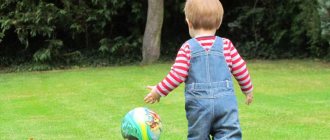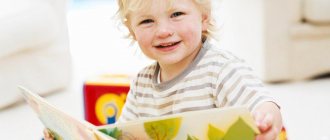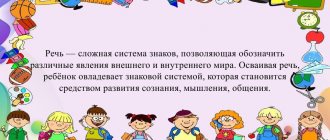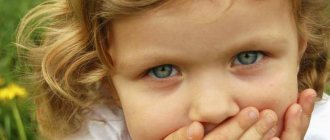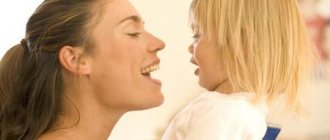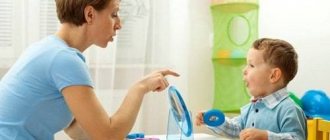The development of a child at 3 years old is actively manifested in all aspects of his activities. These are physical criteria, and mental, and mental, and emotional. Compared to previous years, three-year-old children can already do a lot, reach certain heights, and become more independent. There are many obstacles along the way, one of which is the “three-year-old crisis.” What is it, and how does it manifest itself? Our article will help you understand this and other development issues.
Age characteristics
Let us highlight the following parameters characterizing children of this age:
- The motor (motor) abilities of children are improved. The child more easily controls the coordination of his own body. The step is uniform, there are practically no unnecessary movements, and the pace of walking can be changed without any problems. Three-year-old children are already able to master the control of a tricycle.
- The status of the nervous system is strengthened, efficiency and concentration are increased, and the daily routine changes. Children stay awake for longer periods of time and are able to absorb more new information. In preschool educational institutions, 10-15 minutes are allotted for classes for three-year-old children.
- It is much easier for the baby to hold cutlery in his hands, as fine motor skills develop. The child masters fastening buttons, manipulating clothespins and other objects, drawing with colored pencils, as well as various household skills.
- Speech activity is growing. The vocabulary increases every day, and by the age of three years it is more than 1000 words. The pronunciation of sounds is still unclear, but is on the way to being correct. All parts of speech are used in the speech stream. Children do not always pronounce words correctly, sometimes choosing the wrong endings or confusing syllables. Children voice their actions, try to engage in conversation with adults, and sometimes it may seem that the baby is constantly talking. It is believed that three years is the age of why.
- Game activities become more varied. Role-playing games come into force. A child can come up with interesting stories for his games, as his imagination and abstract thinking develop. It is very useful for parents to play with their children and come up with entertaining games.
On the playground, many kids are always interested in other people's toys, and, at the first opportunity, they will not miss the chance to play with them.
Child development is a very important and multifaceted process. At three years old, the behavior of most children can undergo changes, and raise many questions and misunderstandings among parents. Thinking that she made the wrong step in raising the baby, the mother begins to worry. These are absolutely natural changes in the lives of children of this age category.
At this age, the baby is gradually approaching a “psychological crisis”, which will occur more than once on the path of development. The very first manifestations of behavior problems are a crisis at the age of three.
From the end of the second year of life it gradually increases and reaches a peak at three years. Manifestations depend on the character traits of the little person, and range from violent hysterics to conflict behavior.
Signs of crisis 3 years
- A child may not listen to adults and insist on his opinion. Stubbornness appears.
- Lacking his own expressed desires, he responds negatively to all requests from an adult. Pronounced negativism.
- Actions that were previously performed without visible problems are now regarded as undesirable. The baby refuses to eat, brush his teeth, or wear certain clothes.
- Manifestation of constant independence, especially in those moments when it is absolutely inappropriate. Denial of any adult help.
- Behavior leading to conflict. Riots, protests against parents' requests.
- Reluctance to play and put toys away correctly. The child throws, breaks or spoils surrounding objects demonstratively.
- One of the frequently observed changes in behavior is jealousy, which can be directed not only at other children in the family, but also at dad towards mom.
According to psychologists, such behavioral problems are caused by the baby’s awareness as an independent unit. It seems to the baby that he is already an adult and capable of making decisions. With this behavior, the child demands respect. Throws hysterics, screams, rebels against the command of his parents. The emotional state of the child is difficult to bear not only by the parents, but also by himself, since he does not understand what is happening and why his mood has deteriorated.
One of the common manifestations of a crisis is hysterics, which are a means of manipulation. This is a significant difference between hysterics of an earlier age, since there the task of loved ones was to calm the baby and eliminate the unpleasant. And during a crisis, with such behavior, the child needs “spectators”, so hysterics appear in crowded places: in a store, on the street.
How to cope with manifestations during a crisis
- Within reasonable limits, allow your child to exercise independence, try changing the communication strategy. If your child can handle things on his own, be patient and give him the opportunity to do things on his own.
- When offering your child a certain event, show your imagination and come up with different options for resolving the situation. In other words, offer the child a choice so that, while realizing his importance, he does not deny the influence of the adult.
- Rephrase the request without forcing the child to do something, say that you need help. For example, you need to walk by the hand not because it is necessary, but because the mother will get lost, and only the baby will help her get somewhere.
- Do not rush your child when performing an action when possible. The more practice your child has in a certain task, the faster he will cope with it next time.
- Try not to follow the baby’s lead or give in to hysterics. If the baby understands that by shouting he got the desired object, he will develop stereotypical behavior. And next time he will understand that hysterics are the easiest option to get what he wants.
- Try to react as calmly as possible to hysteria on the street, don’t pay attention, ignore it. During this period, such a demonstration of performance is a test of strength.
- Don't scold your child after a tantrum. Better explain how you can express dissatisfaction and negative emotions in words.
Talk to your child more often, surround him with care and love. The consequences of the crisis disappear with age-related changes. The formation of character and relationships in the family occurs with the help of such necessary life obstacles, but they are very quickly forgotten and later remembered with the most positive emotions.
What to do with a 3 year old child at home (games)
You are probably wondering what to do with a 3-year-old child at home and what educational toys can be used for 3-year-old children:
Balloon
What you need
Small paper plates Wooden sticks Balloons (any size) Jump rope
What to do
Take small paper plates and attach them to wooden sticks to create "tennis rackets." Blow up the balloon behind the "ball". Use the jump rope to split the "court" in half and see how many times you can throw the balloon over the line before it hits the ground.
A fun variation of this game is to use the racket plate to see how long you can both keep the balloon in the air. Or, if there are other kids around, get them all involved and play tennis with two or three.
Homemade twister
What you need
Ribbon Scissors made of colored paper
What to do
Create your own twister game for you and your family! First, cut out large squares of red, blue, yellow and green paper and glue them to the floor. Then, using the same colors, cut out the shape of the arm and leg.
You can then draw shapes at random to indicate direction. For example, when your child chooses a card with a yellow hand on it, they can easily interpret that they should place their hand on the yellow square. For more advanced children, you can add "right" or "left" to the instructions.
Collage of leaves
What you need
Clear plastic sticky back Leaves or petals (or construction paper) Baby scissors
What to do
Developmental activity for children aged 3 years and older: create a collage of leaves to hang in the window. Cut two sheets of clear adhesive plastic to the desired size (30cm square is good). Peel back the paper to reveal the sticky side of one sheet and apply to leaves and petals of different sizes and colors. Then peel and place another sheet of plastic with a sticky back over it. Now you have a collage to hang in your window. This also works with cut pieces of paper if leaves are not always available.
Tiny ships
What you need
Walnuts Toothpick Paper Modeling clay
What to do
Using walnut shells, your child can create boats that actually float. Take a clean half shell and place a small amount of modeling clay in the bottom. Stick a toothpick into the clay. Cut out a small square sail from paper and attach it to a toothpick. Place it in water and watch it float.
Private picnic
What you need
Tablecloth, sheet or blanket Picnic basket or canvas bag Plates and napkins Snacks
What to do
On those long winter days when you can't get outside, your little one will love having an indoor picnic. Your child can help you pack a basket or bag full of easy-to-eat foods such as sandwiches, chopped fruits and vegetables, and oat bars.
What to do with a 3-year-old child at home: together you can lay out a tablecloth or sheet on the floor and lay out plates and napkins. Then sit down and enjoy a wonderful picnic together. For added fun, imagine all the things you would see around you if you were having a picnic in nature. Just be careful that an imaginary squirrel doesn't steal your sandwiches!
Child 3 years old video:
Physical development of children at three years old
Compared to the physical parameters of 2.5 years, a baby can gain about a kilogram of weight and grow by 4-5 cm. The physical parameters of boys are slightly higher than girls at this age.
The parameters are given in approximate proportions and may not coincide with the indicators of some children.
Development standards:
| Options | Boys | Girls |
| Weight, g. | 11350 – 18350 | 10850 – 18150 |
| Height, cm | 88.9 -104,5 | 88.4 – 102,4 |
| Chest circumference, cm | 51 – 56 | 49 – 55 |
| Head circumference, cm. | 46.7 – 52.6 | 45.6 – 51.4 |
Teaching a child to clean up after himself
By instilling discipline, you can instill in your child the skill of neatly putting things in their place, being organized, and being clean. At 1.5 - 2 years old, a child should know where his socks, T-shirts, cars, and dolls are kept. Involve him in cleaning up his toys before bedtime, ask him to take out a blue sweater for a walk from the bottom drawer. So, at 3 years old, your baby will be able to help you put your personal belongings in their places without reminders, but immediately after undressing. Many parents note that the habit of cleaning up after themselves creates a reluctance to scatter things around the apartment.
Young parents should understand that the skills and abilities of a 3-year-old child are not developed in one day. It is necessary to instill rules of behavior and teach the actions of a child from birth, gradually increasing their complexity.
Advertisement
Attention! The use of any medications and dietary supplements, as well as the use of any therapeutic methods, is possible only with the permission of a doctor.
Skills of a child at 3 years old: what should he be able to do?
As pediatricians note, the formation of a child’s personality follows a purely individual development plan. At the age of three, children develop in leaps and bounds, and children’s skills improve by leaps and bounds. Parents can only monitor and celebrate their child’s achievements.
The norms for certain aspects of children's development are highlighted, although it is very difficult to meet children with similar skills. Here is an approximate table with the skills of children aged 3 years.
| Criteria | Required skills |
| Speech abilities |
|
| Mental development |
|
| Psychomotor development |
|
| Household skills |
|
| Motor abilities |
|
| Cognitive development |
|
| Social development |
|
Speech development
The speech skills of a three-year-old child also undergo significant changes. In speech, complex sentences and declension of words by case are used.
How many words can a 3 year old child know?
A three-year-old child's vocabulary consists of 1,500 words.
During this period, the child can easily learn simple poems and songs, and can compose a story based on a picture.
In addition, the baby has the following skills:
- can state his first and last name, place of residence;
- can name the names of his parents;
- makes sentences of 5 words using nouns, adjectives, verbs;
- comments on his actions;
- recognizes and names objects known to him from a picture;
- uses singular and plural words in speech
- asks questions about all subjects and events that interest him;
- actively conducts dialogue with children and adults.
Advice to parents!
It is very important to read a lot to develop your vocabulary. Reading books, memorizing poems and nursery rhymes will not only improve your child’s speech development, but will also be an excellent means of preventing dyslexia.
Daily routine for a three-year-old child
When creating routines, special attention should be paid to sleep. The most optimal ratio for a baby is ten hours of night sleep and two hours of daytime sleep. It is advisable that the child go to bed no later than nine o'clock in the evening. Since at such an early age the central nervous system is not yet strong enough, a later time will not allow the body to rest and gain strength. You can go to bed for a nap after lunch. Such a framework is necessary for a child to adapt without problems to kindergarten.
There are times when children cannot sleep during the daytime. You can allow this regime if the baby slept more than expected at night and did not get tired during the day, and put him to bed earlier at night.
Here's a sample daily routine for a three-year-old:
| Regime moment | Allotted hours |
| Morning rise, hygiene procedures, exercises | 7:00-9:00 |
| Breakfast | 8:00 -9:00 |
| Games, activities | 9:00-10:00 |
| Walk | 10:00-12:00 |
| Dinner | 12:00-12:30 |
| Daytime nap | 12:30-14:30 |
| Getting up, washing | 14:30-15:00 |
| Afternoon snack | 15:00-15:30 |
| Games, activities | 15:30-17:00 |
| An evening walk | 17:00-19:00 |
| Dinner | 19:00-19:30 |
| Calm games | 19:30-20:00 |
| Bathing, hygiene procedures | 20:00-20:30 |
| Reading children's literature | 20:30-21:00 |
| Night sleep | 21:00-7:00 |
Of course, the daily routine depends on the usual way of life of the family and certain features. Mom knows best when to engage her baby with intellectual and developmental games, and when with physical ones. If the time of year and weather conditions permit, it is necessary to go for a walk 2 times a day, and at other times keep the child busy with quiet games, reading fairy tales and other educational literature.
Diet
The nutrition of three-year-old children is practically no different from the adult table. But it is necessary to observe limits in adding seasonings to the main food. A proper diet rich in nutrients is recommended.
The needs of a child of this age include:
- a variety of vegetables, and the addition of potatoes to the diet should not exceed ½ of the total amount;
- fresh fruits;
- fruit and vegetable juices, up to 200 ml. in a day;
- cereals and pasta up to 50 gr. per day;
- You can already give chocolate. Products saturated with the maximum amount of sugar can be 50-60 grams per day;
- 150-170 grams of bread of different varieties;
- chicken eggs - one every other day;
- dairy products: kefir, milk, yogurt, fermented baked milk up to 500 grams;
- cottage cheese, mild cheese;
- Vegetable oil is added to different dishes;
- restrictions on flour products up to 100 grams. in a day.
Meals during the day are 4-5 times.
Sample menu for the day:
| Eating | Dishes |
| Breakfast |
|
| Dinner |
|
| Afternoon snack |
|
| Dinner |
|
Activities for emotional and psychological development
Musical classes and dancing are useful for emotional development, improving sensory and auditory perception. Show funny pictures in the book, learn funny poems and songs. After all, laughter is one of the most positive emotions, and a sense of humor will help a child have a positive attitude towards life in the future and cope with the most difficult situations. Parents should know that cheerful children experience age-related crises much faster and easier. Proper emotional development is no less important for a child than cognitive development. In addition, music, color pictures, books contribute to the development of sensory abilities, imagination, and initiative in children. Only through creativity, which is combined with learning, can children grow and improve their skills.
The construction set develops fine motor skills very well. Its parts can be of different sizes, both large and small. Try building a house out of Lego with your child, then put a bunny in it, and come up with a fairy tale about it together. If you practice early development, you will need the alphabet, Doman cards or Zaitsev cubes, notebooks, albums and other useful material that improves mental skills and logic. The alphabet can also be studied with the help of ordinary books, with letters, pictures and rhymes. The development of mathematical abilities is facilitated by the study of numbers and sequential series; at the age of three, you can already begin to teach your child simple arithmetic operations. The thematic activity should be interesting so that the child does not get bored and lose interest in it.
When using any technique, proper lesson planning is important. Use all the recommendations given in the manual. Only strict adherence to the instructions will help you fully achieve the result. And remember, activities with your child should bring him pleasure. Ask him less about the material he has learned, don’t give him endless tests, and don’t be too strict. Take a responsible approach to choosing the direction of your activity, because at the age of three years, the individual abilities of children already begin to manifest themselves. If a child is calm, intellectual and creative activities are more suitable for him; if he is hyperactive, more attention should be paid to physical development and outdoor games. Don’t forget to read books to your child and teach him poetry. Only in this way can one improve memory and develop correct speech and pronunciation.
Remember, a website or women's forum is not the place where you should look for advice or evaluate your child's development. Only a consultation with a pediatrician or psychologist can help identify the problem. All children are special and develop in their own way. The norms are rather arbitrary, and deviations from them do not always indicate a serious pathology. Regular activities with the child, daily learning through play, love for him and attention, this is what helps the baby grow and learn about the world correctly.
Development of a child's physical abilities
This type is aimed at developing the child’s coordination of movements, developing manual dexterity, and increasing qualities such as endurance.
Classes for physical development must be carried out every day and include the following types of exercises:
- doing exercises accompanied by music;
- stepping over laid out bars or other obstacles;
- teaching a child to walk on an inclined board;
- jumping in place and to music on two legs and on one;
- jumping from small obstacles;
- playing games with simple rules;
- if there is a wall bars at home, this also contributes to a more active pastime.
Help in development: actions of parents
Engage with your baby all the time, but don’t do it for him. Provide the child with materials, explain and help when the child asks.
Exercises
Morning exercises and dancing to music will greatly help your baby. Allow your children to run and play; taking your child to a sports section would be an excellent option.
Toys
You must have:
- pyramids;
- cubes;
- sorters;
- lacing;
- puzzles;
- mosaics;
- constructor;
- books;
- creativity kit;
- baby dolls;
- cars.
Next, focus on the child’s interests and abilities. Give your child his first board game, learn and remember the rules together.
Build a construction set with your child and play interesting games.
Outdoor games
Remember your childhood and games from it. Teach your child to play tag, catch, and ball games. Try badminton. Have a family session at the pool.
Development of cognitive activity
Studying the world around us occurs through increasing the child’s cognitive activity. Such activities develop logic, attention, memory, and thinking. In the form of a game, it is easy for a child to learn about the world around him and get acquainted with mathematical concepts and quantities.
The following exercises will help your baby:
- We look for colors and objects by pattern or name;
- collecting nesting dolls from figurines of different sizes;
- collecting a pyramid of 7-9 rings of different colors and sizes;
- We draw the child’s attention to the concepts of large, medium, small;
- put together puzzles of 6-8 pieces;
- we use lotto, mosaics, and attract the child’s attention to interesting educational games;
- we help to distinguish spatial concepts: right-left;
- get acquainted with numbers and letters. Although three years is still too young to learn the elements of literacy, some children understand and remember letters very quickly, and subsequently learn reading skills much faster.
Motor skills.
A properly selected developmental environment is very important for a baby. What toys should I buy so that they don’t turn out to be superfluous and unnecessary? How to choose in the store exactly what your baby needs according to her age? Read all this in the article: “What toys are needed!”
Skills:
- Undresses and dresses independently (shirt, tights, pants, hat).
- Freely manipulates clothes with buttons.
- Learns to fasten buttons. Large buttons are easy, small ones are difficult.
- Doesn't know how to tie shoelaces yet.
- Brings a plate and spoon for food.
- Can eat thick and liquid foods independently with a spoon. At the same time, he holds the spoon in his right hand, lowering it into the plate, bending slightly over the table.
- Drinks from a cup without spilling the contents. Tries not to dirty clothes and the table.
- Holds bread with his left hand, knows how to bite off small pieces.
- He pays attention to his dirty hands and face, shows the adult that he is dirty, and tries to wipe himself off with a napkin.
- He detects disorder at the table (no napkin, presence of crumbs) and demonstrates his comments.
- Hygiene - lathers hands with soap, washes them in circular motions, places palms under running water, shakes off droplets from hands, wipes them with a towel. Confidently moves a toothbrush over his teeth and a comb through his hair.
- Continues to play in the sandbox and make Easter cakes of different shapes.
Modeling
- He plucks pieces from soft plasticine or dough and crumbles it.
- He knows how to roll sausages, a ball, and loves to squeeze the ball into a flat cake in the form of a saucer. On plasticine cakes he squeezes out seals in the form of a pattern.
- Using a stack (a plastic knife in a set with plasticine), he learns to cut sausages into small pieces.
Visual activities
- Continues to love drawing with paints and felt-tip pens.
- He doesn’t really like to draw with pencils, as he has to press on them. (For proper grip, it is better to use a triangular pencil).
- He knows how to not only draw lines - vertical, horizontal, intersecting, but connects them with specific images (Rain is dripping, grass is growing).
- Draws roundness (circles) like a ball, the sun.
On the topic: Speech development. Setting the sound "SH".
Construction and games with objects:
- Actively uses substitute objects:
“Mom, let’s eat some porridge!” — the child holds out a plastic saucepan full of sand.
"It's a horse!" says the boy, straddling a stick and jumping around the room.
- Quickly folds a pyramid of 6 rings.
- Builds various buildings from cubes that are already involved in the plot. (A house with a pipe for a doll made of cylinders, bricks and a prism, a car made of cubes, a garage made of bricks).
- They are still attracted to rough cubes that can stick together. Takes an active interest in building with Lego.
- Creates a large mosaic. It forms flowers from it - the center is white, the petals are red, etc.
- Learn to play lotto animals. Finds identical pictures and puts them next to each other.
- Developing skills in working with paper - tearing it off, crumpling it into lumps.
- Uses tools for story games. If you need to fix a table or repair a machine, he finds a saw, a screwdriver, and pliers and uses it for its intended purpose.
- Masters the skills of creating a general drawing from 2 cut pictures.
- Adds lacing with large holes to your games. (Tree with fruits).
- Plays finger puppet theater with an adult.
Speech development
All parents dream of seeing their child successful in the future! They try to give him the necessary knowledge and skills, and enroll him in various clubs to acquire skills. Along with physical and intellectual improvement, it is necessary to pay attention to speech development. After all, in any contact with the outside world, a person needs speech, and the better he knows the verbal (through oral speech) method of communication, the simpler and better the process of his communication in society will be.
Speech develops from birth, and the task of adults is to provide the correct speech environment for the baby. It is necessary to constantly talk to the child, without distorting the sound content of words, and not choose long sentences. But, most importantly, talk a lot, not loudly, slightly at a slow pace, so that the child accumulates a vocabulary of words that he can later put into phrases and sentences.
At three years old, the speech of a normotypical child is sufficiently developed; the baby has problems with the pronunciation of sounds, but this is a minor problem for this age.
Please note:
- whether the child correctly understands the speech of an adult addressed to him, whether he can carry out complex instructions;
- how are articulation skills developed, is there any hypersalivation (salivation), can the baby perform simple articulatory movements;
- how the baby develops coherent speech (composing detailed sentences, answering a question in more than one word);
- does he correctly coordinate words in phrases and phrases (for example: “blue sky”, “delicious jam”...);
- is he able to change and form the forms of words (ear - ear, pear - no pears, raspberry jam - raspberry, maple leaf - maple).
Here are examples of some games that promote speech development:
"Young Journalist"
We invite the child to work as a reporter (having previously explained what this means) and write a report about some toy. Tell what kind of toy it is, what material it is made of, what color and shape.
"In the gnome's cave"
We explain that the gnome has everything small, unlike the giant, and if the giant has a “chair”, then the gnome has a “chair” and select any other words.
"The Tale of the Merry Tongue"
Exercises for the development of articulatory motor skills. The fairy tale uses words that denote articulation exercises: “needle”, “cup”, “horse”, “motor”, “delicious jam”, “boat”, “fence”, “window”, “fungus”.
You can come up with your own fairy tale, for example: “Once upon a time there was a tongue!” He woke up in the morning, looked out of the “window” and went for a walk. On the way I saw a “horse” and a “fungus”...
Descriptions of the exercises can be found widely available on any Internet resource dedicated to speech therapy development.
The development of articulation prepares the child to pronounce difficult sounds and words, develops various pronunciation abilities, and eliminates hypersalivation. If you do articulation exercises from an early age, you are more likely to have all the sounds fall into place at the right time.
"Tell me what you hear"
Development of phonemic hearing (distinguishing speech and non-speech sounds).
The child is asked to say what sound he heard. You can use a screen so that the child guesses only by sound, without visual confirmation. For example, the sound of a bell, rustling paper, or the sounds of animals.
Phonemic hearing plays a big role in correct sound pronunciation and learning elements of literacy at an older age.
Activities for physical and mental development
At the age of three, it is important to pay attention to both the physical and mental development of children. Gymnastics should be done daily, for 20-30 minutes. Make it interesting and fun, practice with your child while listening to music. Let the child stretch his arms up, rise on tiptoes and say: “I’m big.” Then he will sit down and say “I’m small.” Ask your baby to stand on one leg for a long time, like a heron, and then alternately jump on one leg or the other. Lying on his back, the child raises his legs, thus pumping his abdominal muscles. Then he lies down on his tummy and tries to reach the back of his head with his toes. Exercises with a large gymnastic ball will be useful. Try to find educational videos or special pictures on the Internet, where exercises for three-year-olds are described in more detail.
By the age of three, children make great progress in speech development. Now they need to be taught to correctly form their thoughts, explain processes and events, and express emotions in words. Games with many questions will help a lot with this. Try with your child to group objects according to characteristics.
For example, find out what can be sweet, cold, high. Prepare cards with pictures, let him lay out and sort objects according to their main characteristics. Teach your child to navigate time. You can start mastering the calendar with it, let it remember the names of the seasons and months. Tell him about the sequence of actions. Emphasize that first you wash your hands, and then you can sit down to eat. First of all, you need to put on tights, then panties, then boots, and only after that you go for a walk.
Working with your child on the sequence of rows will be very useful. To do this you will need cards with drawings and color pictures. Children can be drawn on them at different stages of dressing, seasons, morning, day and night. You can start games in which you need to identify identical objects based on characteristics or find extra ones and create semantic pairs. Creative activities, modeling, drawing, and applique should occupy an important place. Let the child fantasize on his own, you just tell him what colors are best to use, what mold will help him create the desired figure. The parts for the appliqués can be ready-made, but it’s a good idea if the child cuts them out himself along the drawn lines. Mandatory materials for activities with a child should be coloring books, colored cards, cubes with letters and numbers, and other educational toys. Please provide comments for any type of activity. By talking to your child, you improve his speech.
Development of fine motor skills
To stimulate speech activity, it is necessary to develop the baby’s fine motor skills. If during a lesson a child uses his fingers, he thereby stimulates the speech zones of the cerebral cortex.
Exercises for development:
- finger gymnastics (using short poems, you can play with your fingers);
- Sand therapy is playing with sand or fine grains. Not only motor skills develop, but also the baby’s imagination;
- fastening buttons, fasteners, Velcro;
- laying out mosaics or various patterns using shells or pasta...
- stringing various beads.
Child sensory development
This development includes the baby’s senses: hearing, vision, tactile sensations, taste, smell. The child improves sensitivity, and therefore the quality of perception of the world around him.
Sample exercises:
- games in a finger pool (the pool is a structure with cells into which various cereals or other bulk materials are poured, including pebbles, buttons, etc.)
- recognition of non-speech sounds (recording of animal voices, insect sounds, sounds of musical instruments...)
- we identify objects or toys by touch;
- We guess products by taste or smell.
Three years is the most favorable period for the development of children. The child perceives positive influences like a sponge, quickly remembers and assimilates information. Treat your baby, show love, and the result of your work will not keep you waiting!
Expression of feelings and emotions.
- Continues to enjoy the capabilities of his body - walk back and forth, run, jump, step over objects.
- Retelling the plot of fairy tales, he empathizes with the main characters, accompanying his feelings with gestures and facial expressions. Uses quotes from fairy tales: “Trouble, trouble, run here quickly!”
- Actively expresses dissatisfaction. May become angry, indignant, complain, muttering and gesticulating.
- Expresses his love through hugs and kisses.
- Still expects parents to show their love and attention.
- Breaks into a smile when he receives approval and praise for his achievements. Waits for verbal encouragement for his successes.
On topic: The donkey and the cuckoo. Logorhythmics.
